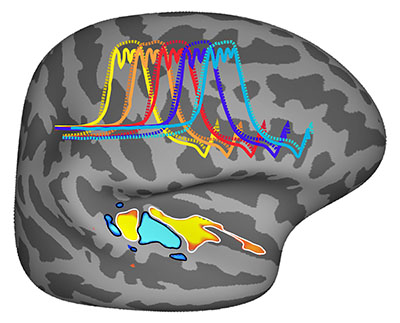A Friendly Bet Turned Major Scientific Discovery
IRP Investigator Bevil Conway Discusses the Science Behind the Headlines

Our brains may be uniquely sensitive to pitch, the harmonic sounds we hear when listening to speech or music, according to a recent study co-authored IRP senior investigator Bevil Conway.
What started as a friendly bet between investigators soon produced a major scientific discovery that calls into question the long-standing notion that non-human primates serve as accurate models for the way human brains function. The study, conducted by IRP investigator Bevil Conway, Ph.D., made headlines recently with reports in outlets such as NPR and U.S. News and World Report. We’re going Behind the Headlines with Dr. Conway to dive deeper into the story, understand the significance of his findings, and see where his work could lead.
Trained as a visual neurobiologist, Dr. Conway has long been intrigued by how the brain turns physical stimuli like light and sound into thoughts and ideas that drive action. He is particularly interested in how the brain transforms the different wavelengths of light entering the eye into a perception of color, and he also seeks to understand how generalizable this process is to other senses. Studying how our senses work can improve our understanding of what might be going wrong when our senses or other cognitive functions go haywire.
“If we want to understand how diseases work, then we need to be able to understand how the normal works,” Dr. Conway explains.
While studying color perception at the Massachusetts Institute of Technology, Dr. Conway met Dr. Norman-Haignere, Ph.D., who was studying the brain’s response to a sound’s pitch — how high or low the sound is — in a similar manner to the way Dr. Conway was studying color. He mentioned to Dr. Conway that his research showed that the human brain responds differently to sounds of different pitches, even in those who are tone deaf. After hearing about this phenomenon, called pitch bias, Dr. Conway wondered if non-human primates also worked this way. Given how similar the visual system is in humans and their close evolutionary relatives, Dr. Conway hypothesized that the macaque monkeys he studied in his lab would possess a pitch bias as well, in which case studying them could yield insights into pitch perception in humans. However, Dr. Norman-Haignere disagreed because pitch is known to be important for language and speech, capacities that monkeys do not appear to possess.
The two scientists eventually decided to settle the dispute with a friendly bet and a study designed to determine whether or not macaques possess a pitch bias. But what started as a weekend experiment quickly turned into a project with an enormous amount of data, as the two scientists realized there are stark differences between the way human and macaque brains respond to pitch. In the end, Dr. Conway was proven wrong: macaques do not possess a pitch bias.
The study’s findings suggest that non-human primates might not be a good model for some aspects of human hearing, such as pitch processing. This surprised Dr. Conway because prior studies had shown humans and macaques to be very similar in the way their brains processed other types of sensory information.
“This paper says, hang on a minute, we need to be rigorous and quantitative about cross-species comparisons and understand to what extent two species are actually similar and comparable,” Dr. Conway says. “In what ways is the macaque monkey a good model for humans, and in what ways is it different? Answering that question is not only important for biomedical research, but also for understanding how primates evolved.”
Research like Dr. Conway’s sheds light on primate evolution by providing insights into the selective pressures and other factors that have shaped our brains to function differently from those of our primate cousins. These selective pressures have created a range of behaviors that appear to be human-specific or are better-developed in humans compared to other species, such as our capacity for music and language. Learning more about the evolutionary forces that influenced our brains could help scientists better understand the way our brains work.
In Dr. Conway’s view, his and Dr. Norman-Haignere’s study exemplifies the intriguing discoveries that can be made when researchers collaborate and learn from one another. Because of their playful bet, we now know that macaques are not the ideal model to study high-level auditory processing in humans. Moreover, the results suggest that scientists should be more aware of the major functional differences between humans and non-human primates.
“There’s something very vulnerable about opening yourself up and collaborating with someone who knows more about an area than you do and vice-versa,” he says. “We need to put our shields down and say, ‘teach me.’ There’s something very productive that can emerge from that honest exchange.”
Learn more about Dr. Conway's research on our news page, and subscribe to our weekly newsletter to stay up-to-date on the latest breakthroughs in the NIH Intramural Research Program.
Related Blog Posts
This page was last updated on Wednesday, May 24, 2023
